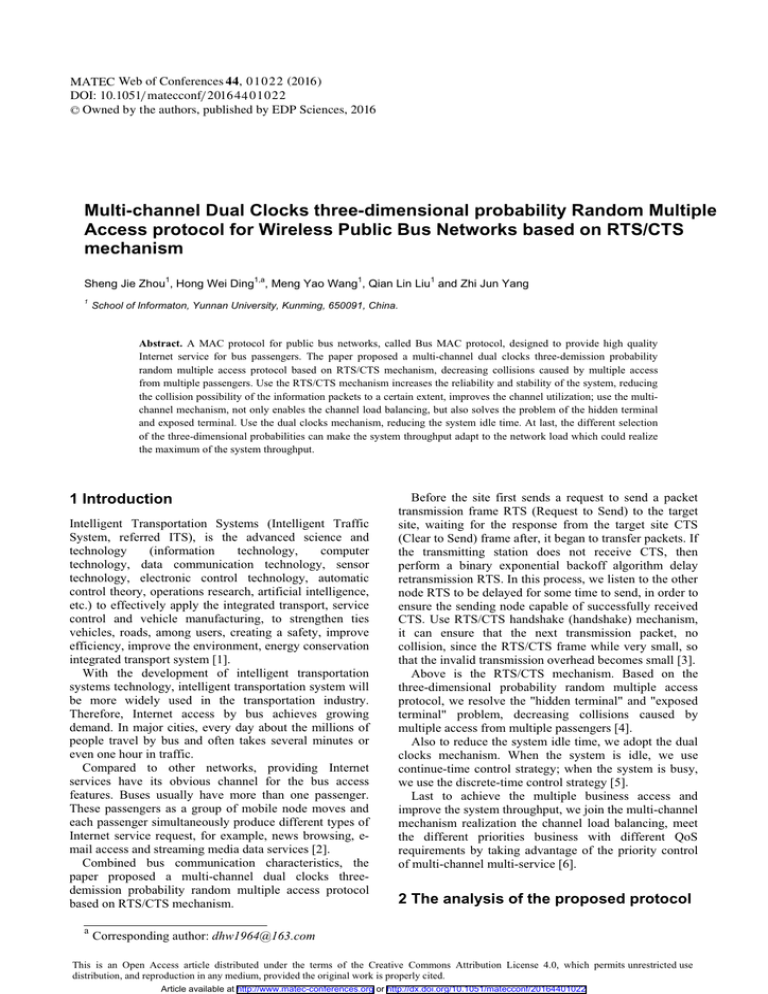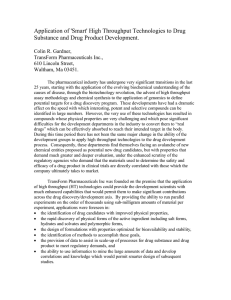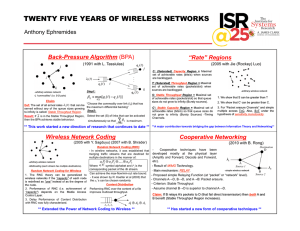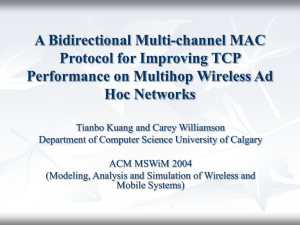Multi-channel Dual Clocks three-dimensional probability Random Multiple
advertisement

MATEC Web of Conferences 4 4, 0 1 0 2 2 (2016 )
DOI: 10.1051/ m atecconf/ 2016 4 4 0 1 0 2 2
C Owned by the authors, published by EDP Sciences, 2016
Multi-channel Dual Clocks three-dimensional probability Random Multiple
Access protocol for Wireless Public Bus Networks based on RTS/CTS
mechanism
Sheng Jie Zhou1, Hong Wei Ding1,a, Meng Yao Wang1, Qian Lin Liu1 and Zhi Jun Yang
1
School of Informaton, Yunnan University, Kunming, 650091, China.
Abstract. A MAC protocol for public bus networks, called Bus MAC protocol, designed to provide high quality
Internet service for bus passengers. The paper proposed a multi-channel dual clocks three-demission probability
random multiple access protocol based on RTS/CTS mechanism, decreasing collisions caused by multiple access
from multiple passengers. Use the RTS/CTS mechanism increases the reliability and stability of the system, reducing
the collision possibility of the information packets to a certain extent, improves the channel utilization; use the multichannel mechanism, not only enables the channel load balancing, but also solves the problem of the hidden terminal
and exposed terminal. Use the dual clocks mechanism, reducing the system idle time. At last, the different selection
of the three-dimensional probabilities can make the system throughput adapt to the network load which could realize
the maximum of the system throughput.
1 Introduction
Intelligent Transportation Systems (Intelligent Traffic
System, referred ITS), is the advanced science and
technology
(information
technology,
computer
technology, data communication technology, sensor
technology, electronic control technology, automatic
control theory, operations research, artificial intelligence,
etc.) to effectively apply the integrated transport, service
control and vehicle manufacturing, to strengthen ties
vehicles, roads, among users, creating a safety, improve
efficiency, improve the environment, energy conservation
integrated transport system [1].
With the development of intelligent transportation
systems technology, intelligent transportation system will
be more widely used in the transportation industry.
Therefore, Internet access by bus achieves growing
demand. In major cities, every day about the millions of
people travel by bus and often takes several minutes or
even one hour in traffic.
Compared to other networks, providing Internet
services have its obvious channel for the bus access
features. Buses usually have more than one passenger.
These passengers as a group of mobile node moves and
each passenger simultaneously produce different types of
Internet service request, for example, news browsing, email access and streaming media data services [2].
Combined bus communication characteristics, the
paper proposed a multi-channel dual clocks threedemission probability random multiple access protocol
based on RTS/CTS mechanism.
a
Before the site first sends a request to send a packet
transmission frame RTS (Request to Send) to the target
site, waiting for the response from the target site CTS
(Clear to Send) frame after, it began to transfer packets. If
the transmitting station does not receive CTS, then
perform a binary exponential backoff algorithm delay
retransmission RTS. In this process, we listen to the other
node RTS to be delayed for some time to send, in order to
ensure the sending node capable of successfully received
CTS. Use RTS/CTS handshake (handshake) mechanism,
it can ensure that the next transmission packet, no
collision, since the RTS/CTS frame while very small, so
that the invalid transmission overhead becomes small [3].
Above is the RTS/CTS mechanism. Based on the
three-dimensional probability random multiple access
protocol, we resolve the "hidden terminal" and "exposed
terminal" problem, decreasing collisions caused by
multiple access from multiple passengers [4].
Also to reduce the system idle time, we adopt the dual
clocks mechanism. When the system is idle, we use
continue-time control strategy; when the system is busy,
we use the discrete-time control strategy [5].
Last to achieve the multiple business access and
improve the system throughput, we join the multi-channel
mechanism realization the channel load balancing, meet
the different priorities business with different QoS
requirements by taking advantage of the priority control
of multi-channel multi-service [6].
2 The analysis of the proposed protocol
Corresponding author: dhw1964@163.com
This is an Open Access article distributed under the terms of the Creative Commons Attribution License 4.0, which permits XQUHVWULFWHGXVH
distribution, and reproduction in any medium, provided the original work is properly cited.
Article available at http://www.matec-conferences.org or http://dx.doi.org/10.1051/matecconf/20164401022
MATEC Web of Conferences
2.1 The analysis of RTS/CTS mechanism
The channel model of three-dimensional random multiple
access protocol is shown in Figure 1.
In I events, at idle time slot a , if there is only one
information packet to be sent, its possibility is:
q11
ap1Ge ap1G
(3)
At the transmission period, if there is no information
packets to be sent, its possibility is:
q20
Figure 1. The channel model of three-dimensional random
multiple access protocol
In this model, there will be three random events:
zEvent that information packets are sent successfully
(U events).
zEvent that information packets collide with each
other (the collision appears, C events).
zEvent that there are no information packets in the
channel arrive, the channel is idle (I events) [7].
These three events are forced into: the channel is idle (I
events) event, the channel is busy (CU events) and the
channel is idle following the CU events (CUI events); the
packet is sent successfully or unsuccessfully (combined C
events with U event, denoted by CU event); force the CU
events and the CUI events into B events [8].
According to the new protocol, if the channel is idle,
then the user decides to send an information packet
probability P1 ; if the channel is in transmission time, the
user
listens
to
the
channel
with
probability P2 and P3 repectively in time 1 and a . This
control strategy, P1 , P2 and P3 by three-dimensional
selection enables the system utilization and throughput is
guaranteed under different load.
The channel model of three-dimensional random
multiple access protocol based on RTS/CTS mechanism
is shown in Figure 2.
NAK 2WKHUV
W R WC
1
a a a
ACK 2WKHUV
W R WC
1
a a a
{ p2 [
P( N I
P( N B
P( N I
i)
(e
ap1G i 1
9
] p3 }G
) e
{ p 2 [
(1 e ap1G )(1 e
j)
i, N B
32
9
(3 a W R W C ] p3 }G
23
23
{ p2 [
32
9
(3 a W R W C ] p3 }G
23
23
(6)
) j 1 (7)
i I events and
(e ap1G ) i 1 (1 e ap1G )
j)
(1 e
{ p2 [
32
9
(3 a W R W C ] p3 }G
23
23
)
j 1
(8)
e
{ p 2 [
32
9
(3 a W R W C ] p3 }G
23
23
The averages number of i continuous I events in a cycle
is:
f
f
¦¦ iP( N
E(NI )
I
i, N B
j)
(9)
i 1 j 1
f
f
¦¦ i(e
ap1G i 1
) (1 e
ap1G
)
i 1 j 1
(1 e
{ p2 [
32
9
(3 a W R W C ] p3 }G
23
23
) j 1 e
{ p2 [
32
9
(3 a W R W C ] p3 }G
23
23
1
1 e ap1G
The average number of j continuous B events in a cycle
Tn is:
f
E( NB )
f
¦¦ jP( N
I
i, N B
j)
i 1 j 1
f
f
¦¦
(10)
j (e ap1G )i 1 (1 e ap1G )
i 1 j 1
Figure 2 The channel model of three-dimensional random
multiple access protocol based on RTS/CTS mechanism
The transmission period is divided into the following
sections under the control of the protocol: an
interrogation signal RTS, the response signal CTS, an
information packet transmission time 1, ACK monitoring
signal a , other information content: 9˄1 3a W W ˅,
C
and the delay time a .
When there are n information packets arriving, the
process of channel satisfying the Poisson process, the
probability is˖
(aG )n e aG
(1)
P ( n)
n!
In I events, at idle time slot a , if there is no information
packets to be sent, its possibility is:
e ap1G
(3 a W R W C In a cycle, the possibility of continuous
j B eventsis:
Tn
q10
32
In a cycle, the possibility of continuous j B events is:
BU
R
(4)
23
23
Ge
In a cycle, the possibility of continuous i idle events is:
I
23
32
9
(3 a W R W C ] p3 }G
23
23
{ p2 [
In the transmission period, if there is only one
information packet to be sent, its possibility is:
32
9
q12 { p2 [ (3a W R W C ] p3 }
(5)
23
23
a a a
TP
e
(2)
(1 e
{ p2 [
32
9
(3 a W R W C ] p3 }G
23
23
) j 1 e
{ p2 [
32
9
(3 a W R W C ] p3 }G
23
23
1
1 e
{ p2 [
32
9
(3 a W R W C ] p3 }G
23
23
To the discrete time three-dimensional probability
random multiple access protocol with RTS/CTS
mechanism, the information packets are sent successfully
in two cases.
Firstly the number of information packet transmitted
successfully in I events are:
q11
ap1Ge ap1G
(11)
E ( NU1 )
1 q10
1 e ap1G
The average length of information packet transmitted
successfully in I events is:
ap1Ge ap1G
(12)
E (U1 ) E ( NU1 ) u1
1 e ap1G
Secondly the average length of continuous K U events
in the TP time in a cycle is:
01022-p.2
ICEICE 2016
f
f
i 1
¦¦ ¦ KP( N
E (U 2 )
2.3 The analysis of multi-channel mechanism
j ) u1
i, N B
I
i 1 j 1K 0
f
f
i 1
¦¦ ¦ K (e
(13)
ap1G i 1
) (1 e ap1G )
i 1 j 1K 0
(1 e
{ p2 [
{ p2 [
32
9
(3 a W R W C ] p3 }G
23
23
) j 1 e
{ p2 [
32
9
(3 a W R W C ] p3 }G
23
23
32
9
(3a W R W C ] p3 }G
23
23
In a cycle, the average length of time slot that
information packet has been successfully sent is:
E (U1 ) E (U 2 )
E (U )
ap1Ge ap1G
32
9
{ p2 [ (3a W R W C ] p3}G
1 e ap1G
23
23
(14)
The average length of B event in is:
32
E(B) E(NB ) u ˄1 3a W R WC˅
23
32
˄1 3a W R WC˅
23
{ p2 [
1 e
(15)
32
9
(3aW R WC ] p3 }G
23
23
Assuming that nodes have different service requirement
have different priorities, setting N traffic channels in the
system, the node occupies the channel according to their
business priorities. Assume that each priority unlimited
the number of users, the priority from low to high in
order is priority 1, priority 2… priority N.
Priority 1 occupies the channel 1, priority 2 occupies
channel 1 and channel 2… priority i occupies channel 1
to channel i. The arrival information packets on the
channel i subject to the Poisson distribution with arriving
rate Gi , the arrival packets of priority r on the channel i
subject to the Poisson distribution with arriving rate
Oi Gi / ( N i 1) . The multichannel mechanism owning
N channels is showed in Figure 3.
The average length of I event is:
a
(16)
1 e ap1G
The throughput of the three-dimensional probability
random multiple access protocol with RTS/CTS
mechanism is:
E(I )
E(NI ) u a
E (U )
E ( B) E ( I )
S
(17)
ap1Ge ap1G
32
9
{ p2 [ (3a W R W C ] p3}G
1 e ap1G
23
23
32
˄1 3a W R W C˅
a
23
32
9
{ p2 [ (3 a W R W C ] p3 }G
1 e ap1G
23
23
1 e
Figure 3 The multichannel mechanism owning N channels
In the N channels of wireless communication system,
because this channel model is a load equilibrium model,
so the arrival probabilities of each channel are the same,
that is to say:
(20)
G1 G2 G3 Gi GN G
2.2 The analysis of dual clocks mechanism
When the system is idle, the system uses continuous-time
control strategy. And if the system is busy, the system
uses discrete-time control strategy.
Since the number of idle slots I within the geometric
1
, an
distribution with the mean: E ( N )
Basing on the above analysis and computational
formula of the systemic throughput, the system total
throughput is:
S'
32
9
ap1Ge ap1G
{ p2 [ (3a W R W C ] p3}G}
1 e ap1G
23
23
(21)
32
˄1 3a W R W C˅
1
/[ 23 32
(
1)a
9
Gp1a
{ p2 [ (3a W R W C ] p3 }G
1
e
23
23
1 e
Gp a 2eGp1a (1 Gp1aeGp1a eGp1a )a
]
1 Gp1a 2(1 e
)
1 eGp1a
N{
1 eGp1a
information packet arrive in a time slot with normalized
Gp1a
, more than an information
probability: pI 1 Gp1ae
1 eGp1a
packet arrives in a time slot with the normalized
Gp1a
eGp1a .
probability: pI 2 1 Gp1ae
Gp1a
1 e
Then we get:
Gp a 2 e Gp a (1 Gp1ae Gp a e Gp a )a (18)
1
E(I ) (
1) a 1
1
1 e
Gp1a
2(1 e
Gp1a
1
)
1 e
Then according to the above analysis, we can get the
throughput with the priority l :
l
S pl
1
Gp1a
ap1Ge ap1G
32
9
{ p2 [ (3a W R W C ] p3}G}
1 e ap1G
23
23
32
˄1 3a W R W C˅
1
/[ 23 32
(
1)a
9
{ p2 [ (3 a W R W C ] p3 }G
1 e Gp1a
23
23
1 e
Gp a 2 e Gp1a (1 Gp1ae Gp1a e Gp1a )a
]
1 Gp1a 2(1 e
)
1 e Gp1a
1
)S
N i 1
ap Ge ap1G
1
32
(22)
){ 1 ap1G { p2 [ (3a W R W C 1 e
23
i 1 N i 1
32
˄1 3a W R W C˅
9
1
] p3 }G} / [ 23 32
(
1)a
9
Gp1a
{ p2 [ (3 a W R W C ] p3 }G
e
23
1
23
23
1 e
Gp a 2 eGp1a (1 Gp1ae Gp1a e Gp1a )a
]
1 Gp1a 2(1 e
)
1 e Gp1a
l
(¦
E (U )
E ( B) E ( I )
{
(¦
i 1
The throughput of the dual clocks three-dimensional
probability random multiple access protocol with
RTS/CTS mechanism is:
S
NS
(19)
3 Experimental
analysis
01022-p.3
classification
results
and
MATEC Web of Conferences
Based on the above analysis, with the use of simulation
tool: MATLAB R2010a, the simulation results are shown
as following. During the simulation, transmission delay
time: a 0.1 , W R W C 0.1 , packet length is: 32˄1 3a W W ˅.
23
R
C
Figure 7 The throughput of the new protocol with different a.
Figure 4 The throughput of the new protocol with different P1.
Figure 8 The throughput of new protocol with different tr, tc.
Figure 5 The throughput of the new protocol with different P2.
Figure 9 The difference of system idle time between the new
protocol and the traditional one.
Figure 6 The throughput of the new protocol with different P3.
01022-p.4
ICEICE 2016
Figure 10 The throughput of the new protocol with 3 channels.
access protocol based on RTS/CTS mechanism. By
introduction of the RTS/CTS mechanism increases the
reliability and stability of the system, reducing the
collision possibility of the information packets to a
certain extent, improves the channel utilization; by the
use of the multi-channel mechanism, not only enables the
channel load balancing, but also solves the problem of the
hidden terminal and exposed terminal. By introduction of
the dual clocks mechanism, reducing the system idle time.
The different selection of the three-dimensional
probabilities can make the system throughput adapt to the
network load which could realize the maximum of the
system throughput. At last, system simulation coincides
with the theoretical value higher degree of consistency
proved the theoretical derivation, and proves the accuracy
of the simulation.
Figure 11 The throughput the new protocol with 5 channels.
Through the above simulation results, we can draw the
following conclusions:
1, system simulation coincides with the theoretical value
higher degree of consistency proved the theoretical
derivation, and proves the accuracy of the simulation.
2, through P1, P2 and P3, we achieve regulation on the
system throughput. At low load, P1 increases system
throughput can be improved; however, at a high load, P1
increases will reduce the throughput. Because of the low
load increases the transmission probability may increase
the probability of successfully transmitted packets, and
transmit high load increases the probability it will cause
more serious conflict. Similarly, when a low load, P2
make a small increase system throughput will increase; a
high load, increasing the probability P2 collisions will
increase dramatically reduces system throughput.
Therefore, we can make the probability of a combination
of P1, P2 and P3 at optimum circumstances mentioned in
the throughput is greater.
3, by introducing the dual clock mechanism, it can really
reduce the idle rate of the system, especially at low load,
idle rate of the system is reduced by a big margin;
because at high load, the system is idle rate already high,
so the capacity of the mechanism at a high load reducing
system idle rate weakened; and in different combinations
of probability, idle rate of the system is reduced rates are
not the same.
4, and finally through a multi-channel mechanism, not
only improves the overall throughput of the system, but
also to achieve the different priorities for different bus
passengers, providing a different throughput access to
multiple services.
Acknowledgements
This work was supported by the National Natural Science
Foundation of China (61461053, 61461054, 61072079);
Natural Science Foundation of Yunnan Province
(2010CD023); The Financial Support of Yunnan
University (No.XT412004).
References
1.
2.
3.
4.
5.
6.
7.
4 Conclusions
With the development of intelligent transportation
systems technology, for providing high quality Internet
service in public buses, combined bus communication
characteristics, the paper proposed a multi-channel dual
clocks three-demission probability random multiple
8.
01022-p.5
Shengjie Zhou, Hongwei Ding, Yifan Zhao, Zhijun
Yang and Qianlin Liu. Research on the discrete time
three-dimensional probability csma protocol in adhoc network [J]. International Journal of Recent
Scientific Research, 2015, 6(5): 4257-4262.
Xuming. Research and development of mobile Ad
Hoc network [J]. Data Communications, 2003 (4):
15-18.
Conti M, Giordano S. Mobile ad hoc networking:
milestones, challenges, and new research directions
[J]. Communications Magazine, IEEE, 2014, 52(1):
85-96.
Gandhi C, Arya V. A Survey of Energy-Aware
Routing Protocols and Mechanisms for Mobile Ad
Hoc Networks [M]. Intelligent Computing,
Networking, and Informatics. Springer India, 2014:
111-117.
Xiaoping Wu. Research on the hidden and exposed
terminal problem in the Ad Hoc network [J].
Microcomputer Information, 2006 (10X): 35-37.
Jayasuriya A, Perreau S, Dadej A, et al. Hidden and
exposed terminal problem in ad hoc networks[D].
ATNAC 2004.
Wang L, Wu K, Hamdi M. Attached-RTS:
Eliminating an Exposed Terminal Problem in
Wireless Networks [J]. IEEE Transactions on
Parallel and Distributed Systems, 2013, 24(7): 12891299.
Dongfeng Zhao. Study on A New Method for
Continuous-time Systems of Random Access
Channel [J]. Journal of Electronics, 1999, 21(1): 3741.






